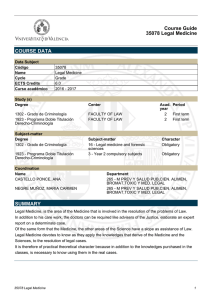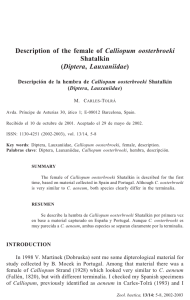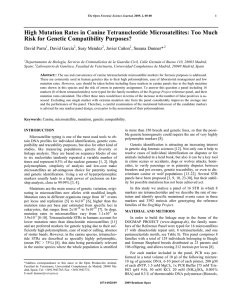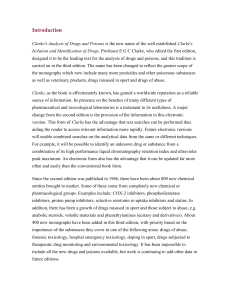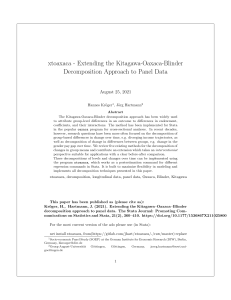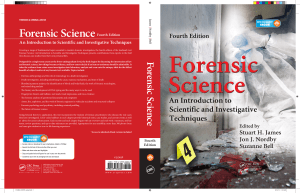Arthropods of forensic interest associated to pig carcasses in Aiako
Anuncio
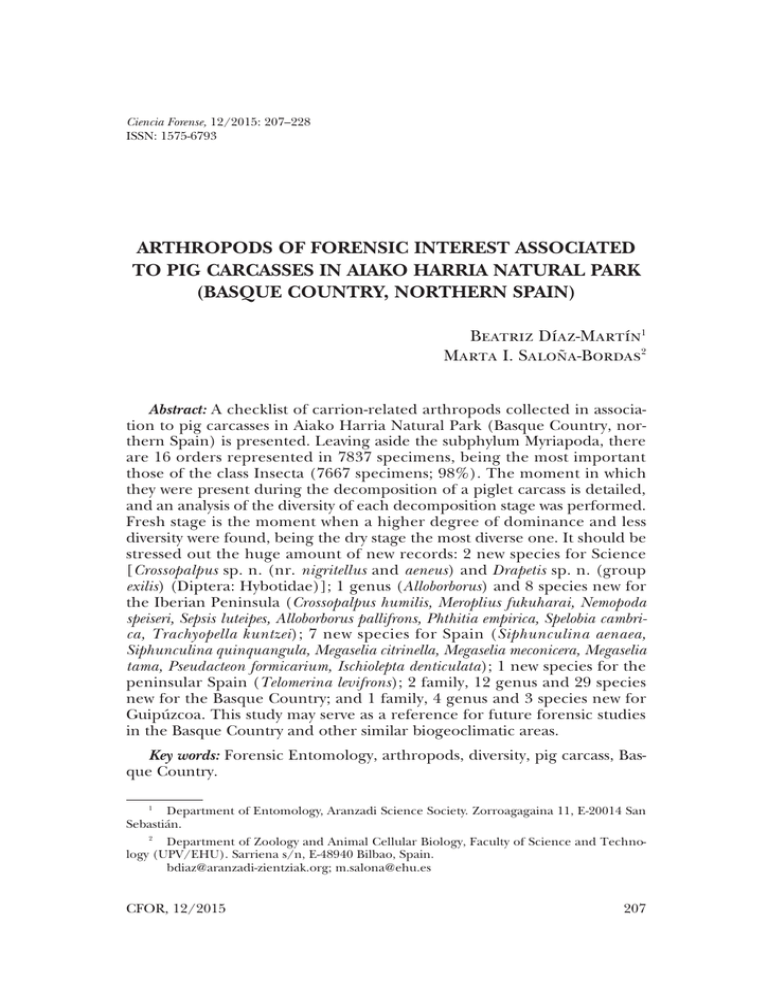
Ciencia Forense, 12/2015: 207–228 ISSN: 1575-6793 ARTHROPODS OF FORENSIC INTEREST ASSOCIATED TO PIG CARCASSES IN AIAKO HARRIA NATURAL PARK (BASQUE COUNTRY, NORTHERN SPAIN) Beatriz Díaz-Martín1 Marta I. Saloña-Bordas2 Abstract: A checklist of carrion-related arthropods collected in association to pig carcasses in Aiako Harria Natural Park (Basque Country, northern Spain) is presented. Leaving aside the subphylum Myriapoda, there are 16 orders represented in 7837 specimens, being the most important those of the class Insecta (7667 specimens; 98%). The moment in which they were present during the decomposition of a piglet carcass is detailed, and an analysis of the diversity of each decomposition stage was performed. Fresh stage is the moment when a higher degree of dominance and less diversity were found, being the dry stage the most diverse one. It should be stressed out the huge amount of new records: 2 new species for Science [Crossopalpus sp. n. (nr. nigritellus and aeneus) and Drapetis sp. n. (group exilis) (Diptera: Hybotidae)]; 1 genus (Alloborborus) and 8 species new for the Iberian Peninsula (Crossopalpus humilis, Meroplius fukuharai, Nemopoda speiseri, Sepsis luteipes, Alloborborus pallifrons, Phthitia empirica, Spelobia cambrica, Trachyopella kuntzei); 7 new species for Spain (Siphunculina aenaea, Siphunculina quinquangula, Megaselia citrinella, Megaselia meconicera, Megaselia tama, Pseudacteon formicarium, Ischiolepta denticulata); 1 new species for the peninsular Spain (Telomerina levifrons); 2 family, 12 genus and 29 species new for the Basque Country; and 1 family, 4 genus and 3 species new for Guipúzcoa. This study may serve as a reference for future forensic studies in the Basque Country and other similar biogeoclimatic areas. Key words: Forensic Entomology, arthropods, diversity, pig carcass, Basque Country. 1 Department of Entomology, Aranzadi Science Society. Zorroagagaina 11, E-20014 San Sebastián. 2 Department of Zoology and Animal Cellular Biology, Faculty of Science and Technology (UPV/EHU). Sarriena s/n, E-48940 Bilbao, Spain. [email protected]; [email protected] CFOR, 12/2015 207 Beatriz Díaz-Martín, Marta I. Saloña-Bordas Resumen: Presentamos un primer listado de artrópodos relacionados con restos cadavéricos en el Parque Natural de Aiako Harria (País Vasco, norte de España). Sin considerar al subphylum Myriapoda, hemos encontrado 7837 especímenes representados en 16 órdenes, siendo los más importantes los correspondientes a la clase Insecta (7667 especímenes, 97%). Se especifica el momento de la descomposición cadavérica en que se encontraron, así como el valor de la diversidad en cada fase de descomposición cadavérica. En el estado fresco se obtiene el mayor valor de dominancia y el menor valor de diversidad, siendo el estado seco el más diverso de todos. Debemos destacar la cantidad de nuevos taxones recolectados: 2 nuevas especies para la Ciencia [Crossopalpus sp. n. (nr. nigritellus and aeneus) y Drapetis sp. n. (grupo exilis) (Diptera: Hybotidae)]; 1 género (Alloborborus) y 9 especies nuevas para la Peninsula Ibérica (Crossopalpus humilis, Meroplius fukuharai, Nemopoda speiseri, Sepsis luteipes, Alloborborus pallifrons, Phthitia empirica, Spelobia cambrica, Trachyopella kuntzei); 7 nuevas especies para España (Siphunculina aenaea, Siphunculina quinquangula, Megaselia citrinella, Megaselia meconicera, Megaselia tama, Pseudacteon formicarium, Ischiolepta denticulata); 1 nueva especie para España peninsular (Telomerina levifrons); 1 familia, 11 géneros y 28 especies nueva para el País Vasco; y 1 familia, 4 géneros y 3 especies nuevas para Guipúzcoa. Este estudio servirá como referencia para futuros estudios forenses en el País Vasco y otras áreas biogeoclimáticas similares. Palabras clave: Entomología forense, artrópodos, diversidad, restos cadavéricos, País Vasco. 1. INTRODUCTION Arthropods are main responsible of the consumption of corpses and carcasses, reducing them to skeleton in few days under adequate conditions. They feed on the body, and live or breed in/on a corpse, thus depending on their biological preferences, and on the state of body decomposition. This produces a faunal succession which varies through season and environmental conditions, and that can be useful for the estimation of time since death (1, 2). However, the evaluation and use of succession patterns have necessarily been based on the adequate knowledge of the insect fauna in the region in which a corpse is discovered, as species vary widely with geographic region (3, 4). This sort of information is often generated in forensics through field experiments based on carrion decomposition in which nonhuman carcasses are usually employed, due to legal impediments on using human corpses as models (5, 6). If this baseline fauna is unknown, then the forensic entomologist needs to draw upon the existing bibliography and choose the one which deals with areas of similar characteristics, although the accuracy of post-mortem interval estimations will be diminished (4, 7). 208 CFOR, 12/2015 Arthropods of forensic interest associated to pig carcasses in Aiako Harria Natural Park... In the Iberian Peninsula, detailed studies in this field are scarce, and other papers contribute data only for certain groups (8). Besides, they have been performed in central and southern areas of the Iberian Peninsula (5, 8, 9, 10, 11), remaining the northern region unexplored. This lack of information is a particularly important problem, as the predominant climate types of our peninsula differ considerably, and the typical Atlantic climate of the Basque Country makes unfeasible any extrapolation of the data without assuming a great error on post-mortem calculations. Therefore, this study is aimed to contribute to increase the knowledge of our fauna with an extensive inventory of carrion-associated arthropods, including information about their successional patterns, in order to create a database of reference for regions with similar biogeoclimatic characteristics. 2. MATERIAL AND METHODS Sampling procedure The collection of samples was realized during the ongoing of a field experiment focused on insect succession on carrion during summer months in 2009 and 2010. It took place in «Aiako Harria» Natural Park (Errenteria, Guipúzcoa, Spain), concretely in an unused area of the Urdaburu-Añarbe forest which previously served for the recuperation of wild board populations (12). It was, however, noticeable the recreational use of surrounding areas and the intermittent presence of livestock and horses. Five domestic piglets (Sus scrofa Linnaeus, 1758) were sacrified each year for the research. Pigs are considered the best non-human model because of their similarities regarding body size, skin, organs and tissue structure, or diet (13, 14, 15). Carcasses laid over a metallic net on the forest ground, with a minimum distance of 10 meters between them, and covered with a jail to prevent the action of scavengers. For more details, previous works can be consulted (12, 16, 17). Flying adults were daily collected with handheld insect net upon decomposing carcasses, helped with forceps or paintbrushes to collect specimens directly from carcasses or surrounding area. Samples were preserved in ethanol 70% and properly labeled, keeping them in the reference collection of the Forensic Entomology Laboratory, University of the Basque University (UPV/EHU, Biscay, Spain). Identification Due to the vast increase in number of known forms of animals and to the continuous renovation of the classification, mechanisms of modern taxonomy have become so complex as to beginners discourage (18). Moreover, arthropods constitute the most important group in terms of CFOR, 12/2015 209 Beatriz Díaz-Martín, Marta I. Saloña-Bordas number and diversity of the Animal Kingdom. For all these reasons, multidisciplinary teams are needed for an accurate identification of all the species involved in the carcass reduction. That for, the first step in the identification process is to divide the collected arthropods in groups (taxa), following experts’ instructions or the last review published by the Spanish Association of Entomology (19). More specific keys were used for genus and species level, confirming the findings with experts on each group. Some taxa were entirely sent to the specialist, depending on the difficulty of each group. For the most abundant and better studied groups, the following taxonomic keys were used: — Coleoptera: Bahillo de la Puebla (unpublished data); Charrier, 2002 (20); Martín Piera & López Colón, 2000 (21); Prieto Piloña & Pérez Valcárcel, 2002 (22); Yelamos, 2002 (23). — Diptera (adults and maggots): Manuel Castillo (unpublished data); Szpila & Grzywacz (unpublished data); González Mora, 1989 (24); Peris & González Mora, 1991 (25); Rognes (1980, 1991, 1998) (26, 27, 28); Rozkošný et al., 1997 (29). For more complex taxa, the following specialists aid in the identification process: — Coleoptera r $BSBCJEBF+FTÙT-FODJOB r )JTUFSJEBF5PNÃT:ÊMBNPT r -FJPEJEBF+BWJFS'SFTOFEB r /JUJEVMJEBF1BCMP#BIJMMP r 4UBQIZMJOJEBF3BJNVOEP0VUFSFMP r 5SPHJEBF1BCMP#BIJMMP+FTÙT3PNFSP4BNQFS — Diptera r "HSPNZ[JEBF.JMPØþerný r $IJSPOPNJEBF0TDBS4PSJBOP r $IMPSPQJEBF&NJMJB1/BSUTIVL r &QIZESJEBF5BEFVT[;BUXBSOJDLJ r 'BOOJJEBF"OES[FK(S[ZXBD[ r .VTDJEBF,S[ZT[UPG4[QJMB"OES[FK(S[ZXBD[ r 1IPSJEBF)FOSZ%JTOFZ r 1TZDIPEJEBF3ÛEJHFS8BHOFS r 4BSDPQIBHJEBF%PMPSFT(PO[ÃMF[.PSB r 4DBUPQTJEBF+FBO1BVM)BFOOJ 210 CFOR, 12/2015 Arthropods of forensic interest associated to pig carcasses in Aiako Harria Natural Park... r 4DJBSJEBF,BJ)FMMFS r 5BDIJOJEBF)BOT1FUFS5TDIPSTOJH r "DBSUPQIUIBMNJEBF $BSOJEBF )FMFPNZ[JEBF .JMJDIJJEBF Opomyzidae, Piophilidae, Sepsidae, Sphaeroceridae, Syrphidae, Tabanidae, Ulidiidae: Miguel Carles Tolrá r $FSBUPQPHPOJEBF %PMJDIPQPEJEBF &NQJEJEBF )ZCPUJEBF Daniel Ventura — Hemiptera: Xanti Pagola — Quelicerata: r "SBDIOJEB"MCFSUP$BTUSP Opportunistic and accidental species will not be examined in detail, focusing the analysis and discussion on taxa of forensic interest. Nevertheless, it is worth noting that they may also provide useful information when carrion fauna is considered as a whole (3, 30, 31), so they are also included, at least at class level. All these material is kept in ethanol of 70º and can be found in the arthropod collection of the Forensic Entomology research group of the University of the Basque University (UPV/EHU, Leioa, Bizkaia, Spain). Analysis of diversity It is also of interest to check out the effect of changes in the environment on the community. That for, it is necessary to have previous information about the biologic diversity of the community (species richness or į diversity) and the rate of change or replacement in species composition between different communities (Ȗ diversity) (32). In the absence of species information on several taxa, all calculations have been made at family’s level, with the statistical software PAST (33) (Table 2). The easiest and commonest way to evaluate the diversity is based on Margalef index, which estimates the rate at which species are added when expanding the sample. This index is used for comparison with previous works. Nevertheless, it is strongly influenced by sampling effort, so Fisher index was also calculated, as it enables a more objective comparison between samples (32, 34). It is also advisable to quantify the representativeness of the species, to improve the understanding of the community diversity. Hence, it has been calculated the Simpson’s index, which is strongly influenced by the importance of the most dominant species. On the other hand, decomposition process can be understood as a temporal gradient, and therefore the rate of species replacement through time PGEFDPNQPTJUJPOXBTFWBMVBUFE'JH 8JUIUIJTBJNJUIBTCFFODBMDVMBCFOR, 12/2015 211 Beatriz Díaz-Martín, Marta I. Saloña-Bordas ted the turnover rate, which gives a percentage of similarity between successive time periods [cf. Magurran, 2004 (34)]: t= a+b NA + NB where a and b are the number of species present only in sample A and B respectively, and NA and NB are the total number of species in each sample. Assisted by the statistical software PAST, the Bray-Curtis dissimilarity index (1-D) is also reported, as it takes into account not only the presence or absence of species, but also their abundance (32). Both indexes show complementarily if the community composition changes through time and, if so, how it does. 3. RESULTS A total of 7837 adult specimens were collected during the research, which ascribed up to 255 known species and remaining 21 taxa/families unidentified and pendant of a more detailed revision. Figure 1: Main taxa collected during the whole experiment (from left to right: subphylum, class, order). Notice that the length of lines does not imply a meaning of evolutive distance between groups. 212 CFOR, 12/2015 Arthropods of forensic interest associated to pig carcasses in Aiako Harria Natural Park... Leaving aside the subphylum Myriapoda, there are 16 orders represented (Fig. 1), being the most important those of the class Insecta (Fig. 2). Diptera is the predominant order (82%), with 30 families and more than 177 species collected. They are followed by coleopterans (12%), with 13 families and more than 58 species; and Hymenoptera (3%). Relative abundance of the dominant families is shown in Fig. 2.3. Figure 2: Relative abundance of the main groups of arthropods collected, with detail of Diptera and Coleoptera main families. Table 1 reports the presence/absence of the different taxa associated to each stage of decomposition, as well as the total number of specimens collected during the whole experiment. Information about new records is also included, detailing the region for which the taxon is first reported. To analyse the diversity, indexes of common used are shown in Table 2. Advanced Decay stage is the one with the higher abundance, but it is the Dry stage where the higher diversity was found, estimated both with Margalef and Fisher indexes. Regarding Simpson index, it is lowest during the Fresh stage, indicating that probably one or more taxa have a high degree of dominance. CFOR, 12/2015 213 Beatriz Díaz-Martín, Marta I. Saloña-Bordas Table 1: Presence/Absence of arthropods, with the total number of each taxon in both 2009 and 2010. New record of species, genera or family are specified with a superindex (G: Guipuzkoa; BC: Basque Country; S: Spain; SP: Spanish Peninsular territory; IP: Iberian Peninsula); names in bold report to new species for the Science. n.c.: not countified. ORDER / FAMILY SPECIES STAGE OF DECOMPOSITION F B AcD AdD D NUMBER DIPTERA ACARTHOPHTHALMIDAEG AcarthophthalmusG bicolorBC AGROMYZIDAE Liriomyza pusilla ANTHOMYIDAE Unidentified species CALLIPHORIDAE Bellardia sp. x x x 5 x 1 x x 9 x x 13 23 Calliphora vicina x x x x x Calliphora vomitoria x x x x x 67 Chrysomya albiceps x x x x x 154 Lucilia ampullacea x x x x 27 Lucilia caesar x x x x 926 Lucilia illustris x x x Lucilia sericata x 5 x 1 x Polenia rudis CARNIDAEBC Rhiniinae (un. sp.) x MeoneuraBC neottiophilaBC x x x CECIDOMYIDAE Unidentified species CERATOPOGONIDAE Culicoides (Avaritia) scoticus x x CHIRONOMIDAE SubFam Orthocladiinae CHLOROPIDAE Oscinella frit x x 1 1 x x x x 2 1 x 1 5 Siphunculina quinquangulaS x x x Tricimba cincta x DOLICHOPODIDAE Chrysotus gramineus x EPHYDRIDAE Hydrellia sp. x 1 1 Siphunculina aenaeaS 214 7 1 Forcipomyia (Euprojoannisia) titillans Forcipomyia (Forcipomyia) ciliata 18 1 x Culicoides (Culicoides) impunctatus Culicoides (Silvaticulicoides) pallidicornis x x Meoneura sp. 1 5 2 1 1 CFOR, 12/2015 Arthropods of forensic interest associated to pig carcasses in Aiako Harria Natural Park... ORDER / FAMILY FANNIIDAE SPECIES STAGE OF DECOMPOSITION F B AcD AdD x x x Fannia fuscula x x x x 17 x x x x x 43 x x x x Fannia scalaris Fannia sp. Crossopalpus humilisIP x x Drapetis sp. n. (group exilis) MILICHIIDAE LeptometopaBC latipesBC MUSCIDAE Azelia sp. x x x x x 2 1 x 1 x 13 x 2 x 84 x 2 1 x x x 9 Graphomya sp. x x x x 9 Gymnodia sp. x x x x 3 Eudasyphora sp. x Hebecnema sp. Hydrotaea aenescens x x Hydrotaea armipes x x x x x x x x Hydrotaea capensis Hydrotaea dentipes x x Hydrotaea ignava Hydrotaea pilipes Hydrotaea similis x Hydrotaea sp. x Morellia sp. x Musca autumnalis x x 53 22 x x x x x x x Other Muscidae species Geomyza tripunctata x 2 x 58 x x 4 x x 14 x 4 x x 8 x x 5 x 1 x 10 x 5 x x 12 x x x 157 x x Myospila sp. Stomoxys calcitrans 3 x x Phaonia sp. 64 x x Mydaea sp. x x Muscina pascuorum x 15 x Muscina levida Muscina prolapsa 28 x x x x 6 x Musca domestica CFOR, 12/2015 352 x x Dasyphora albofasciata OPOMYZIDAE 3 x x Crossopalpus sp. n. (nr. nigritellus y aeneus) 17 x x Suillia affinis Suillia variegata HYBOTIDAE NUMBER x Fannia manicata HELEOMYZIDAE D Fannia canicularis x 5 x 1 215 Beatriz Díaz-Martín, Marta I. Saloña-Bordas ORDER / FAMILY PHORIDAE SPECIES STAGE OF DECOMPOSITION F B AcD AdD x Conicera tibialis x Megaselia citrinellaS Megaselia giraudii x 1 1 x 1 x x 4 x x 4 x 1 Megaselia sp near angusta x x x 5 Megaselia sp A x x x 3 Megaselia verna Megaselia sp B x Megaselia sp C x x Pseudacteon formicarumS x Pseudacteon lundbecki x Liopiophila varipes x x ParapiophilaBC vulgarisBC x x 441 x x 48 x 1 x x 13 x x x Protopiophila latipes x x x x x x x 5 2 x ProchylizaBC nigrimanaBC StearibiaG nigricepsG 2 x x PiophilaBC caseiBC Piophila megastigmataBC 1 1 x Metopina perpusilla 216 1 x Megaselia tarsalis SARCOPHAGIDAE 71 x Megaselia tamaS PSYCHODIDAE 1 x x Megaselia meconiceraS PIOPHILIDAE x x Megaselia elongata 2 3 Megaselia albicaudata x NUMBER 2 x Diplonevra florescens Megaselia brevicostalis D x Conicera floricola 6 x 118 x 1447 Psychoda albipennis x 4 Psychoda minuta x 1 Psychoda cf. surcoufi x 3 Psychoda sp. x 1 Tinearia alternata x 1 x 5 Sarcophaga (Bellieriomima) subulata x 2 Sarcophaga (Helicophagella) noverca x 1 Ravinia pernix x Sarcophaga (Parasarc.) aratrix x x 2 Sarcophaga (Sarc.) pyrenaica x x 3 CFOR, 12/2015 Arthropods of forensic interest associated to pig carcasses in Aiako Harria Natural Park... ORDER / FAMILY SARCOPHAGIDAE SPECIES Sarcophaga albiceps STAGE OF DECOMPOSITION F B x AcD AdD x x 1 Coboldia fuscipes x 3 Thripomorpha cf. coxendix x 1 Bradysia angustipennis x 1 Bradysia hilaris-Gr. x 1 Bradysia subrufescens x 1 Bradysia sp. x 1 Cratyna sp. x 1 x x 9 Lycoriella cellaris x 2 Phytosciara sp. x 1 Phytosciara (Dolichosciara) flavipes x 1 x 1 Pnyxia scabiei Scatopsciara atomaria Scatopsciara multispina x Other Sciaridae species x MeropliusBC fukuharaiIP x Meroplius minutusBC x x x 2 x x 86 x x 16 1 x x x 295 x x x 45 Nemopoda speiseri x x x 6 Sepsis fulgens x x x 27 Nemopoda nitidula x IP Sepsis luteipesIP x x x x 17 Sepsis punctum x x x x 28 x x 5 x 7 Other Sepsidae species SIMULIDAE Unidentified species SPHAEROCERIDAE AlloborborusIP pallifronsIP x 1 x Bifronsina bifrons BorborillusG vitripennisG x Chaetopodella scutellaris x Coproica hirticulaBC x x 347 x x 7 x x 260 16 3 x x x x x x x x 41 x x x 18 x x ElachisomaBC aterrimumBC Elachisoma bajzaeBC x x Coproica rohaceki Coproica vagansG 3 x Coproica lugubrisBC Coproica pusio x x Coproica ferruginata CFOR, 12/2015 16 20 x Hyperlasion wasmanni SEPSIDAE NUMBER x x Sarcophaga sp. SCIARIDAE x x Sarcophaga incisilobata SCATOPSIDAE D x x x 35 x x 15 x x 10 217 Beatriz Díaz-Martín, Marta I. Saloña-Bordas ORDER / FAMILY SPHAEROCERIDAE SPECIES STAGE OF DECOMPOSITION F B AcD AdD Elachisoma pilosumBC x GonioneuraBC spinipennisBC Ischiolepta denticulataE x 7 x 2 43 x x x x 5 x x 5 x x 22 x x 22 Opalimosina colliniBC x 2 Opalimosina czernyiBC x 1 x x 76 x x 9 x x 24 x x 16 x 19 x Minilimosina fungicolaBC Minilimosina parvulaBC x Norrbomia costalis x x Opalimosina liliputanaBC x Opalimosina mirabilisBC Opalimosina simplexBC Paralimosina fucata x x 2 1 OpalimosinaBC calcariferaBC x x Phthitia empiricaIP x Spelobia baeziBC Spelobia clunipes x Spelobia luteilabris x x x x x 7 x x x 37 x x 69 x x x Spelobia nanaBC Spelobia palmata x Sphaerocera curvipes x 3 x Spelobia cambricaIP 4 2 x x 5 Telomerina flavipes x x x 12 Telomerina levifronsSP x x x 39 Terrilimosina schmitzi x TrachyopellaBC kuntzeiIP x x 11 x x 38 Trachyopella lineafronsBC x x Other Sphaeroceridae species 2 x x x 1 x 10 Eristalis similis x 1 Meliscaeva cinctella x 1 Episyrphus balteatus x Syritta pipiens 218 1 x x MinilimosinaG alloneuraBC TACHINIDAE NUMBER x x Leptocera caenosa TABANIDAE x x Ischiolepta vaporariorumBC SYRPHIDAE D 1 Dasyrhamphis atra x 1 Tabanus bromius x 1 Peribaea tibialis x 1 Voria rurales x 1 Winthemia cf. quadripustulata x 7 CFOR, 12/2015 Arthropods of forensic interest associated to pig carcasses in Aiako Harria Natural Park... ORDER / FAMILY ULIDIIDAE SPECIES STAGE OF DECOMPOSITION F B AcD AdD Euxesta pechumani D NUMBER x 2 x 1 COLEOPTERA APHODIDAE Unidentified species CARABIDAE Steropus (Steropus) madidus CLERIDAE Necrobia ruficollis x x x Necrobia rufipes Necrobia violacea x x 10 x x 15 Unidentified species DERMESTIDAE Dermestes frischii x x Dermestes mustelinus x x 3 Dermestes undulatus x x 10 x 124 x 1 Anoplotrupes stercorosus x x 1 CURCULIONIDAE GEOTRUPIDAE x 3 x x x x x Sericotrupes niger 6 x 1 x x 142 Carcinops pumilio x x 7 Hister unicolor x x 3 x x 24 Thyphaeus thypoeus Trypocopris pyrenaeus HISTERIDAE 6 Margarinotus (Ptomister) brunneus x x x x x Saprinus (Saprinus) planiusculus Saprinus (Saprinus) semistriatus x Saprinus (Saprinus) subnitescens Unidentified species x x 3 x x x 6 x x x 15 x x x x 55 LEIODIDAE Sciodrepoides fumatus x x 18 Sciodrepoides watsoni x NITIDULIDAE Nitidulidae sp. x 8 Omosita colon x 12 x 14 x 2 x Omosita depressa Omosita discoidea OEDEMERIDAE Unidentified species SILPHIDAE Necrodes littoralis x x x x x x Oeceoptoma thoracica Tanatophilus rugosus Tanatophilus sinuatus CFOR, 12/2015 1 x 141 x 24 x 1 x Nicrophorus humator Nicrophorus vespilloides x x 1 1 1 x 2 219 Beatriz Díaz-Martín, Marta I. Saloña-Bordas ORDER / FAMILY STAPHYLINIDAE SPECIES STAGE OF DECOMPOSITION F B AcD AdD x Acrotona pygmaea Acrulia inflata x Aleochara (s.str.) curtula x x Aleochara (s.str.) stichai Anotylus complanatus x x x NUMBER 10 x 1 x 22 x 1 x x Anotylus sculpturatus 8 1 x 3 x 1 x x 7 x 6 x x 3 Autalia impressa x 2 Autalia puncticollis x 1 x 38 Atheta (Microdota) amicula x Atheta (Microdota) indubia Atheta (Microdota) mortuorum Atheta (s.str.) aquatica Atheta (s.str.) fungicola Bisnius fimetarius x x x Creophilus maxillosus x x x x 46 x 5 x 2 x 3 Megarthrus denticollis x 1 Myrmecopora (Iliusa) fugax x 1 x x 2 x 9 x 12 Dimetrota nigripes x Drusilla canaliculata x Gabrius exiguus 1 x Gyrohypnus (s.str.) fracticornis Ontholestes tesellatus Oxytelus (Epomotylus) sculptus x x x Philonthus cochleatus x x x x x Philonthus coprophilus Philonthus nitidus x Philonthus politus x x x 1 x 1 x 11 12 x x x x 4 x x 27 Proteinus brachypterus x 3 Rugilus (s.str.) orbiculatus x 1 Tachinus flabolimbatus x 2 Other Staphylinidae species x 9 Philonthus succicola Philonthus varians x Platysthetus arenarius TROGIDAE Trox scaberBC OTHER families Unidentified species 220 D x x x x x 3 x x 133 CFOR, 12/2015 Arthropods of forensic interest associated to pig carcasses in Aiako Harria Natural Park... ORDER / FAMILY SPECIES STAGE OF DECOMPOSITION F B AcD AdD D NUMBER HYMENOPTERA HYMENOPTERA x x x x x 100 FORMICIDAE Unidentified species x x x x x 136 LEPIDOPTERA x 1 EXOPTERYGOTA PSOCOPTERA x 6 THYSANOPTERA x 2 HEMIPTERA CICADELLIDAE Unidentified species CIXIIDAE Unidentified species x x DELPHACIDAE Unidentified species x 6 ISSIDAE Issus coleoptratus x 3 ANTHOCORIDAE Xylocoris (Proxylocoris) galactinus x 5 CERATOCOMBIDAEBC CeratocombusBC (Ceratocombus) coleoptratusBC x x 4 COREIDAE Coreus marginatus marginatus x x 3 LYGAEIDAE Scolopostethus affinis x 1 PENTATOMIDAE Piezodorus lituratus APHIDIDAE Unidentified species x x x x 4 x 1 x 1 x x 3 OTHER TAXA DERMAPTERA x COLLEMBOLA x x PROTURA x DIPLURA MYRIAPODA x 3 x 67 x 6 x 1 DIPLOPODA x 1 CHILOPODA x 20 x 23 x n.c. Diplocephalus latifrons x 3 Erigone dentipalpis x 1 Tiso vagans x 2 Centromerita concinna x 1 Centromerus sylvaticus x 4 Diplostyla concolor x 3 Tenuiphantes sp. x 2 Tenuiphantes flavipes x 6 ISOPODA CHELICERATA ACARI x x x x ARACHNIDA LINYPHIIDAE Tenuiphantes tenuis CFOR, 12/2015 x 1 221 Beatriz Díaz-Martín, Marta I. Saloña-Bordas ORDER / FAMILY STAGE OF DECOMPOSITION SPECIES LYCOSIDAE F B AcD AdD x Pardosa sp. Pardosa lugubris x Trochosa terricola SALTICIDAE Heliophanus sp. THERIDIIDAE Episinus truncatus D x NUMBER 4 x 1 x 5 x x 1 1 OPILIONIDA x 10 PSEUDOSCORPIONIDA x 4 Table 2: Diversity indexes associated to the decomposition stages calculated with the statistical software PAST (Hammer, 2001). STAGE OF DECOMPOSITION FRESH BLOATED ACTIVE DEC. ADVANCED DEC. DRY Number of Individuals 755 412 1120 3250 2300 Number of Taxa 24 20 30 37 47 Margalef index 3,471 3,156 4,13 4,452 5,943 Fisher index (alpha) 4,724 4,394 5,67 5,853 8,362 Simpson index (1-D) 0,6145 0,8153 0,8633 0,7645 0,9035 Dissimilarity was highest during the first and last moments of decomposition (Fig. 3A), remaining lower between those moments. On the other hand, species replacement expressed by turnover rate indicated a very low change on species identity during the first stages (Fig. 3B), so the most important changes were in the abundance of the species present. These findings agree with results summarised on Table 2. Fresh stage was characterised by dominant species which become less important in number with the arrival of new species during the ongoing of bloated stage, resulting in that peak of dissimilarity. After this first moment, species replacement kept constant. 222 CFOR, 12/2015 Arthropods of forensic interest associated to pig carcasses in Aiako Harria Natural Park... Figure 3: A) Bray-Curtis dissimilarity index graphical representation from data calculated with the statistical software PAST (Hammer, 2001); B) Turnover [t=(a+b)/(NA + NB)]. 4. DISCUSSION Arthropods, scavengers and microbes compete for cadaveric resources on a dynamic process of colonization, development and succession patterns (35). Natural inhabitants of the soil disappear (36, 37), and this new ephemeral CFOR, 12/2015 223 Beatriz Díaz-Martín, Marta I. Saloña-Bordas ecosystem provided by the dead corpse becomes dominated by cadaveric fauna, from which the most important is the class Insecta (more than 97% of the total). This result is much greater than the 70-86% proposed by other authors (38, 39, 40). It is also important to remark that, although mites are already under revision and not included in the report, they can provide forensically important information (41, 42) and will be studied in detail in future research. From the class Insecta, the most abundant families belong to the orders Diptera and Coleoptera, both making up to 94% of the total necrophagous fauna found on carcasses. Most of the reliable forensic indicators are found among the families of these orders (39). There is also an important amount of new records (see Table 2) that denotes the low level of knowledge of the carrion fauna in our region. As a brief summary, the following new records are pointed out for Diptera: a) 2 new species for Science: Crossopalpus sp. n. (nr. nigritellus and aeneus) and Drapetis sp. n. (group exilis) (Diptera: Hybotidae). b) 1 genus and 8 species new for the Iberian Peninsula. c) 7 new species for Spain. d) 1 new species for the peninsular Spain. e) 1 family, 11 genus and 28 species new for the Basque Country. f) 1 family, 4 genus and 3 species new for Guipuzkoa. For Coleoptera, a new record has recently been reported for the species Trox scaber (Coleoptera: Trogidae) in the Iberian Peninsula (43). Such an important amount of new findings gives us an idea about the necessity of increasing the effort dedicated to faunistic studies in some regions (16). Carrion fauna has been found to be very diverse and quite variable. Each stage of decomposition is characterized by a particular group of organisms, each of which occupy a particular niche (39). However, in summer the process occurs fast as the warm temperature and high humidity favour bacterial growing and larval development (30, 38). This leads the dry stage to be the longest one, and therefore, the general trend is for specimens to be captured then (8), so a gradual change in biological diversity (į diversity) is observed. Fresh and bloated stages are characterized by groups of arthropods that depend predominantly on the carrion as their direct source of food. Blowflies may arrive within seconds to the corpse, and maggots take top billing in the carcass reduction (13, 39). These results on the lowest values of Margalef index obtained through the whole process, with a slightly degree of dominance (according to Simpson index values) by the forming maggot mass and fly adults. 224 CFOR, 12/2015 Arthropods of forensic interest associated to pig carcasses in Aiako Harria Natural Park... Very few of these species remain until dry stage (39). Hence, in this stage the dominance becomes less influent and the diversity rise up. In fact, the greatest value on Margalef index occurs on the last stage, concurring with the highest value of Simpson index. Decomposition stages were also analyzed not as independent units, but as a continuous process of changes on the community composition (Ȗ diversity, Fig. 3), and similar conclusions were obtained. Changes from fresh to bloated stage occurred with minimal variations regarding the identity of the families collected, but with major changes in the abundance on each family (there are changes in dominance, which is higher in fresh comparing to bloated stage). By contrast, family replacement is higher in latter stages, although the abundance of each one does not vary significantly (and so the dominance, which is much lower). Several studies have been performed including diversity indexes (8, 43, 44). Most of them also concluded that diversity tended to be higher in late stages of decomposition, but they have not been compared as the sampling methodology, indexes and/or the manner of applying them are not equal. "$,/08-&%(&.&/54 This study was funded by the University of the Basque Country (Vicerrectorado de Investigación, UPV/EHU) and by the Basque Government &"+(7%FQBSUBNFOUPEF"HSJDVMUVSB%FQBSUNFOUPEF&EVDBDJÓO Universidades e Investigación). 6. BIBLIOGRAPHY 1. Benecke M. Six Forensic Entomology Cases: Description and Commentary. Journal of Forensic Sciences 1998, 43(4):797-805. 2. Benecke M. Six Forensic Entomology Cases: Description and Commentary. Forensic Pathology Reviews 2005, 2:207-240. 3. "úöéôì÷û.*(éúëġé.%3÷õíúé&1úíûé++-ýöé". Estimation of postmortem interval based on experimentally obtained entomological evidence. Forensic Science International 2005, 149:57-65. 4. 4ðéúéö÷ÿûóñ#+8éôóíú&("öìíúû÷ö(4. Insect succession and decomposition patterns on shaded and sunlit carrion in Saskatchewan in three different seasons. Forensic Science International 2008, 179:219-240. 5. Prado e Castro C, Serrano A, Martins da Silva P, García MD. Carrion flies of forensic interest: a study of seasonal community composition and succession in Lisbon, Portugal. Medical and Veterinary Entomology 2012, 26:417-431. CFOR, 12/2015 225 Beatriz Díaz-Martín, Marta I. Saloña-Bordas 6. 8íôôû+%-é.÷üüí-3 Estimating the post-mortem interval. In: Forensic Entomology: The Utility of Arthropods in Legal Investigations. Second ediUJPO+)#ZSE+-$BTUOFSFETQQ$3$1SFTT#PDB3BUPO'MPSJEB 2010. 7. "úöéôì÷û.*1úéì÷í$éûüú÷$1úíûé++-ħøíĂ(éôôíï÷&(éúëġé.%. Importancia de los estudios regionales de fauna sarcosaprófaga. Aplicación a la práctica forense. Ciencia Forense 2006, 8:63-82. Œ "úöéôì÷û.*3÷õíúé&1úíûé++-ýöé"(éúëġé.%. Studies on seasonal arthropod succession on carrion in the southeastern Iberian Peninsula. International Journal of Legal Medicine 2004, 118:197-205. 9. Castillo Miralbés M. Estudio de la Entomofauna asociada a cadáveres en el Alto Aragón (España). Monografías de la Sociedad Entomológica Aragonesa (S.E.A.) 6, 2002. 10. García Rojo AM. Estudio de la sucesión de insectos en cadáveres en Alcalá de Henares (Comunidad Autónoma de Madrid) utilizando cerdos domésticos como modelos animales. Boletín de la Sociedad Entomológica Aragonesa (S.E.A.) 2004, 34:263-269. 11. 3÷õíú÷1éôéöë÷+-.ýöïýġé(ñúħö'(éõíú÷-ýëéû+. Entomología cadavérica en la provincial de Cádiz (S. de España). Ciencia Forense 2006, 8:83-106. 12. Díaz Martín B, Saloña Bordas MI. Primera cita y nuevos datos sobre los hábitos necrófagos de Trox scaber (Linnaeus, 1767) (Coleoptera, Trogidae) en la Comunidad Autónoma del País Vasco (C.A.P.V.). Boletín de la Asociación Española de Entomología 2012, 36(1-2):53-59. 13. Catts EP, Goff ML. Forensic Entomology in Criminal Investigations. Annual Review of Entomology 1992, 37:253-272. 14. Goff ML. Estimation of Postmortem Interval Using Arthropod Development and Successional Patterns. Forensic Science Review 1993, 5:81-94. 15. Schoenly KG, Haskell NH, Mills DK, Bieme-Ndi C, Larsen K, Lee Y. Using pig carcasses as Model Corpses to Teach Concepts of Forensic Entomology and Ecological Succession. The American Biology Teacher 2006, 68(7):402-410. 16. Carles-Tolrá M, Díaz B, Saloña MI. Algunos dípteros necrófilos capturados sobre cadáveres de cerdos en el País Vasco (España) (Insecta: Diptera: Brachycera). Heteropterus Revista Entomológica 2012, 12(2):213-222. 17. Ventura D, Díaz B, Saloña MI. Crossopalpus humilis (Frey, 1913) en la Península Ibérica y la relación de la familia Hybotidae con cadáveres de vertebrados (Diptera: Empidoidea: Hybotidae). Boletín de la Sociedad Entomológica Aragonesa (S.E.A.) 2012, 50:527-532. 18. 4ëðíöó&5.ë.éûüíú+) Procedure in Taxonomy. Third edition. Stanford University Press, Stanford, California. 123 pp. 1956. 19. Barrientos+"DPPSE$VSTPQSÃDUJDPEF&OUPNPMPHÎB4PDJFEBEFTQBñola de Entomología (ed.), 947 pp. 20. Charrier S. Clé de determination des Coléoptères Lucanides et Scarabéides de Vendée et de l’Ouest de la France. Le Naturaliste Vendéen 2002, 2:61-93. 226 CFOR, 12/2015 Arthropods of forensic interest associated to pig carcasses in Aiako Harria Natural Park... 21. .éúüġö1ñíúé'-ħøíĂ$÷ôħö+*. Coleoptera, Scarabaeoidea I. In: Fauna Ibérica, vol. 14, Ramos MA et al. (eds.). Museo Nacional de Ciencias Naturales. CSIC. Madrid. 526 pp. 2000. 22. 1úñíü÷1ñô÷ĥé'1ĝúíĂ7éôëĕúëíô+. Catálogo de los Silphidae y Agyrtidae (Coleoptera) de la Península Ibérica e Islas Baleares. Boletín de la Sociedad Entomológica Aragonesa (S.E.A.) 2002, 30:1-32. 23. Yelamos T. Coleoptera, Histeridae. In: Fauna Ibérica, vol. 17, Ramos MA et al. (eds.). Museo Nacional de Ciencias Naturales. CSIC. Madrid. 411 pp. 2002. 24. González Mora D. Los Calliphoridae de España, II: Calliphorini. Eos 1989, 65:39-59. 25. Peris SV, González Mora D. Los Calliphoridae de España, III Luciliini (Diptera). Boletín de la Real Sociedad Española de Historia Natural 1991, 87:187-207. 26. Rognes K. The blow-fly genus Lucilia Robineau-Desvoidy (Diptera, Calliphoridae) in Norway. Fauna Norvegica 1980, 27:39-52. 27. Rognes K. Blowflies (Diptera, Calliphoridae) of Fennoscandia and Denmark. &+#SJMM4DBOEJOBWJBO4DJFODF1SFTT-UE/FX:PSLQQ 1991. 28. Rognes K.'BNJMZ$BMMJQIPSJEBF*O1BQQ-%BSWBT#7PM.BOVBM of Paleartic Diptera. Science Herald, pp. 617-648. 1998. 29. Rozkošný R, Gregor F, Pont AC. The European Fanniidae (Diptera). Acta Scientarium Naturalium Bohemicaea-Brno, 1997. 31(2):1-80. 30. Anton E, Niederegger S, Beutel RG. Beetles and flies collected on pig carrion in an experimental setting in Thuringia and their forensic implications. Medical and Veterinary Entomology 2011, 25(4):353-364. 31. 5÷õêíúôñö+,#āúì+)8éôôéëí+3#íöê÷ÿ.&. Assesment of Decomposition Studies Indicates Need for Standardized and Repeatable Research Methods in Forensic Entomology. Journal of Forensic Research 2012, 3(5):1-10. 32. Moreno CE. Métodos para medir la biodiversidad. MT-Manuales y Tesis de la Sociedad Entomológica Aragonesa (S.E.A.), Vol. 1. Zaragoza. 84 pp. 2001. 33. Hammer Ø, Harper DAT, Ryan PD. PAST: Paleontological statistics software package for education and data analysis. Palaeontologia Electronica, 4(1): 9 pp. http://palaeo-electronica.org/2001_1/past/issue1_01.htm. 2001. 34. Magurran AE. Measuring Biological diversity. Blackwell Science Ltd. 260 pp. 2004. 35. Carter DO, Yellowless D, Tibbett M. Cadaver Decomposition in Terrestrial Ecosystems. Naturwissenschaften 2007, 94:12-24. 36. Bornemissza GF. An analysis of arthropod succession in carrion and its effect of its decomposition on soil fauna. Australian Journal of Zoology 1957, 5:1-12. 37. Saloña MI, Moraza ML, Carles Tolra M, Iraola V, Bahillo P, Yélamos T, Outerelo R, Alcaraz R. Searching the Soil: Forensic Importance of Edaphic Fauna After the Removal of a Corpse. Journal of Forensic Sciences 2010, 55:1652-1655. 38. Horenstein MB, Rosso B, García MD. Seasonal structure and dynamics of sarcosaprophagous fauna on pig carrion in a rural area of Cordoba (ArgentiCFOR, 12/2015 227 Beatriz Díaz-Martín, Marta I. Saloña-Bordas na): Their importance in forensic science. Forensic Science International 2012, 217:146-156. 39. Payne+""TVNNFSDBSSJPOTUVEZPGUIFCBCZQJHSus scrofa Linnaeus. Ecology 1965, 46:592-602. 40. Tantawi TI, El-Kady EM, Greenberg B, El-Ghaffar HA. Arthropod succession on exposed rabbit carrion in Alexandria, Egypt. Journal of Medical Entomology 1996, 33:566-580. 41. Perotti MA. Mégnin re-analysed: the case of the newborn baby girl, Paris, 1878. Experimental and Applied Acarology 2009, 49:37-44. 42. Rasmy AH. The humans lie but the spiders do not lie: An overview on forensic Acarology. Egyptian Journal of Forensic Sciences 2011, 1:109-110. 43. Horenstein MB, Arnaldos MI, Rosso B, García MD. Estudio preliminary de la comunidad sarcosaprófaga en Córdoba (Argentina): Aplicación a la entomología forense. Anales de Biología 2005, 27:191-201. 44. 1úéì÷í$éûüú÷$"úöéôì÷û.*4÷ýûé+1(éúëġé.. Preliminary study on a Community of Sarcosaprophagous Diptera in Central Portugal. Entomologia generalis 2011, 33(3):183-198. 228 CFOR, 12/2015
